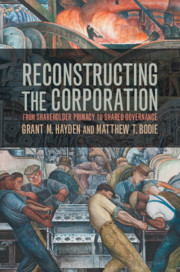Book contents
- Reconstructing the Corporation
- Reconstructing the Corporation
- Copyright page
- Dedication
- Contents
- Preface
- Acknowledgments
- 1 Introduction
- 2 Preference Aggregation in Political Institutions
- 3 Preference Aggregation in Corporations
- 4 The Corporation as Contract
- 5 Shareholder Homogeneity
- 6 The Argument from the Residual
- 7 The Argument from Arrow’s Theorem
- 8 The Shareholder Franchise and Board Primacy
- 9 A Firm-Based Approach to Corporate Voting Rights
- 10 Democratic Participation and Shared Governance
- 11 The German Codetermination Experience
- 12 Conclusion
- Notes
- Index
8 - The Shareholder Franchise and Board Primacy
Published online by Cambridge University Press: 18 February 2021
- Reconstructing the Corporation
- Reconstructing the Corporation
- Copyright page
- Dedication
- Contents
- Preface
- Acknowledgments
- 1 Introduction
- 2 Preference Aggregation in Political Institutions
- 3 Preference Aggregation in Corporations
- 4 The Corporation as Contract
- 5 Shareholder Homogeneity
- 6 The Argument from the Residual
- 7 The Argument from Arrow’s Theorem
- 8 The Shareholder Franchise and Board Primacy
- 9 A Firm-Based Approach to Corporate Voting Rights
- 10 Democratic Participation and Shared Governance
- 11 The German Codetermination Experience
- 12 Conclusion
- Notes
- Index
Summary
This chapter critically examines the rise of board primacy as an alternative theory of firm governance. The chapter begins by categorizing such theorists as either “wise ruler” theorists or “long-term interest” theorists. In either case, board primacy theorists have responded to the revelation that shareholders, like other corporate constituents, have quite heterogeneous preferences not by extending voting rights to those constituents but by further distancing the shareholder electorate from real corporate decision-making. Their move conflates two different aspects of group decision-making processes: the responsiveness of the system and composition of the electorate. And by holding fast to exclusive shareholder voting, the theorists have just further detached their governance structures from the underlying preferences of corporate constituents without substituting anything in their place. We should instead investigate treating other constituents more like shareholders rather than the other way around.
Keywords
- Type
- Chapter
- Information
- Reconstructing the CorporationFrom Shareholder Primacy to Shared Governance, pp. 122 - 144Publisher: Cambridge University PressPrint publication year: 2021

